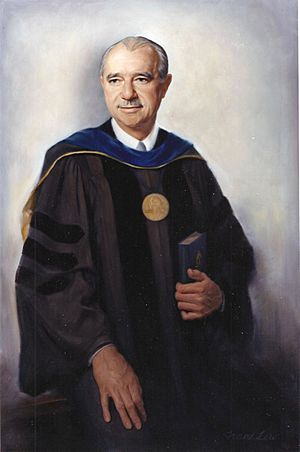Vincent du Vigneaud facts for kids
Quick facts for kids
Vincent du Vigneaud
|
|
|---|---|

du Vigneaud in 1955
|
|
| Born | May 18, 1901 Chicago, Illinois, USA
|
| Died | December 11, 1978 (aged 77) |
| Nationality | American |
| Alma mater | University of Illinois Urbana-Champaign University of Rochester |
| Known for | synthesis of oxytocin and vasopressin |
| Awards | William H. Nichols Medal (1945) Albert Lasker Award for Basic Medical Research (1948) Nobel Prize for Chemistry (1955) Willard Gibbs Award (1956) |
| Scientific career | |
| Fields | Organic chemistry, Peptide synthesis |
| Institutions | University of Edinburgh Johns Hopkins University George Washington University Cornell University |
| Thesis | The Sulfur of Insulin (1927) |
| Doctoral advisor | John R. Murlin |
| Influenced | Panayotis Katsoyannis Iphigenia Photaki |
Vincent du Vigneaud (born May 18, 1901 – died December 11, 1978) was an American biochemist. He was a brilliant scientist who won the 1955 Nobel Prize in Chemistry. He received this award for his important work on chemicals containing sulfur. He was especially recognized for being the first to create a special type of hormone called a peptide hormone. This hormone, called oxytocin, is very important in the body.
Contents
About Vincent du Vigneaud
Vincent du Vigneaud was born in Chicago in 1901. His father, Alfred du Vigneaud, was a French inventor and mechanic. Vincent finished high school in 1918.
Early Interest in Science
Vincent's interest in sulfur started when he was in high school. His new friends invited him to do chemistry experiments. They even made explosives using sulfur!
During World War I, older students had to work on farms. Vincent worked on a farm near Caledonia, Illinois. He became very good at milking cows. This experience made him want to become a farmer.
However, his older sister, Beatrice, convinced him to study chemistry. He then enrolled in chemical engineering at the University of Illinois at Urbana-Champaign. He was very inspired by his teachers, Carl Shipp Marvel and Howard B. Lewis. They were both very excited about sulfur, which made Vincent even more interested.
Vincent did not have much family support. He took on many odd jobs to pay for his studies. He earned his Master of Science (MS) degree in 1924. After that, he worked for a company called DuPont.
Family Life and Further Studies
Vincent met Zella Zon Ford on June 12, 1924. He was working as a waiter while studying at university. They later got married.
In 1924, his former teacher, Carl Marvel, helped him find a job. Vincent became an assistant biochemist at the Philadelphia General Hospital. This job also allowed him to teach clinical chemistry at the University of Pennsylvania. Marvel even paid for Vincent's trip to Pennsylvania. In return, Vincent had to prepare 10 pounds of a chemical called cupferron.
In 1925, Vincent went back to his studies. He joined the research group of John R. Murlin at the University of Rochester. He worked on his PhD thesis there. In 1927, he earned his PhD with his research titled The Sulfur of Insulin.
Working Around the World
After his PhD, Vincent worked with John Jacob Abel at Johns Hopkins University Medical School from 1927 to 1928. He then traveled to Europe in 1928 and 1929. He was a special research fellow.
In Europe, he worked with famous scientists like Max Bergmann and Leonidas Zervas. They were at the Kaiser Wilhelm Institute for Leather Research in Dresden. He also worked with George Barger at the University of Edinburgh Medical School. After his time in Europe, he returned to the University of Illinois at Urbana-Champaign as a professor.
In 1932, he started working at the George Washington University Medical School in Washington, D.C.. Then, in 1938, he moved to the Cornell Medical College in New York City. He stayed there until he retired in 1967. After retiring, he continued to work at Cornell University in Ithaca, New York.
In 1974, Vincent had a stroke, which made him retire completely. He passed away in 1978, a year after his wife died in 1977.
Amazing Discoveries in Chemistry
Vincent du Vigneaud's career focused on chemicals that contain sulfur. He was especially interested in peptide hormones. These are hormones made of small chains of building blocks called peptides.
Understanding Hormones
Before winning the Nobel Prize, he was already famous for his work. He researched important substances like insulin, biotin, and penicillin.
His Nobel Prize-winning work was about two specific hormones: oxytocin and vasopressin. He figured out their exact chemical structures. Then, he was the first scientist to create them in a lab. This was a huge step forward in chemistry and medicine!
He also studied how changing parts of oxytocin and vasopressin affected their actions. This was one of the first times such detailed studies were done for peptides. He wrote a book about his research called A Trail of Research in Sulphur Chemistry and Metabolism and Related Field.
Awards and Recognition
Vincent du Vigneaud joined a science club called Alpha Chi Sigma in 1930. This was when he was at the University of Illinois at Urbana-Champaign.
His most famous award was the 1955 Nobel Prize in Chemistry. He received it for his groundbreaking work on sulfur compounds. He was especially honored for being the first to create a peptide hormone in the lab. This was a major achievement in the world of science.
See also
 In Spanish: Vincent du Vigneaud para niños
In Spanish: Vincent du Vigneaud para niños
- University of Rochester
- List of Nobel Laureates affiliated with the University of Rochester

